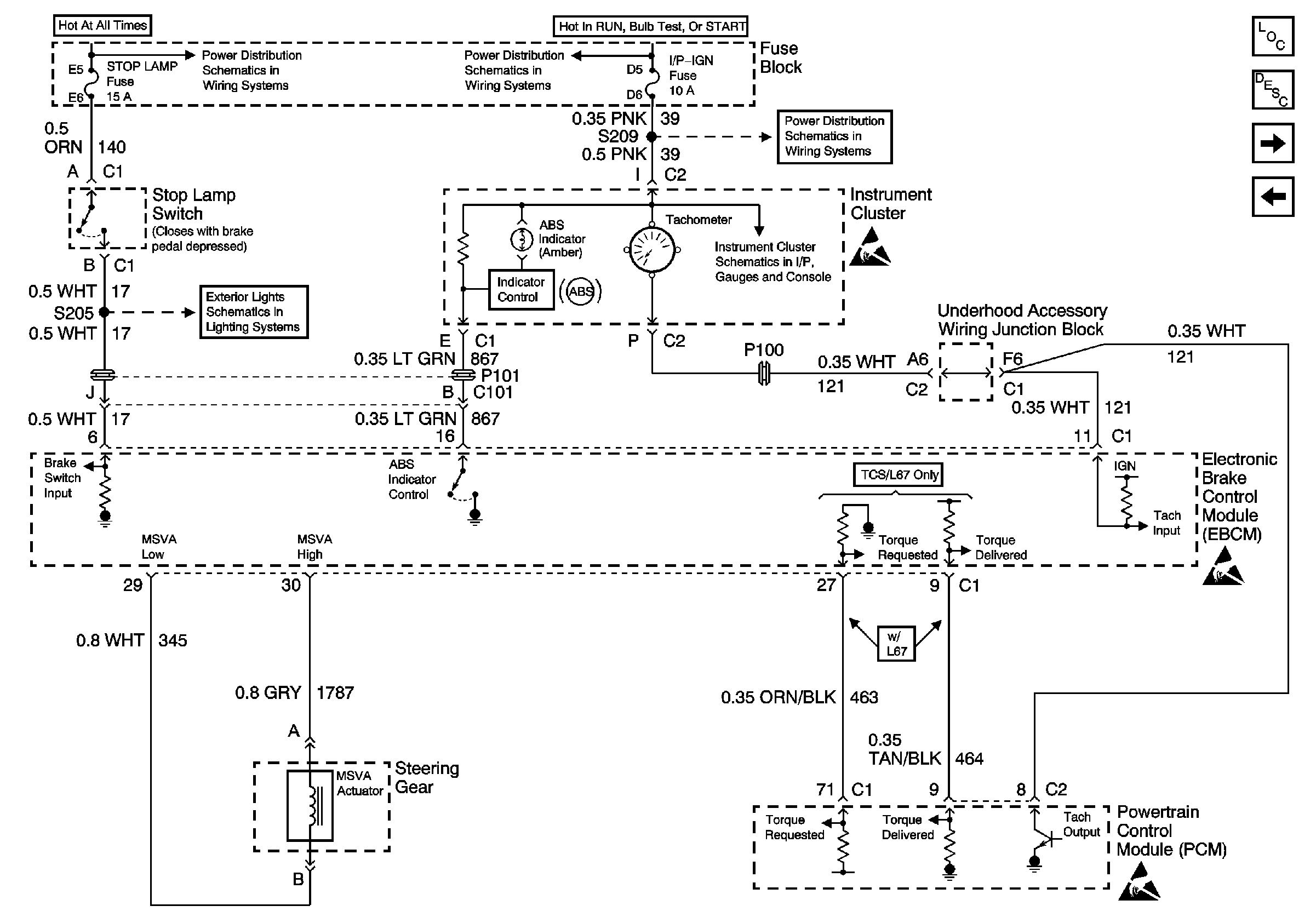Circuit Description
The RPM signal circuit provides the EBTCM with an indication of engine RPM to help determine TCS control methods and rates when a TCS event takes place.
Conditions for Setting the DTC
The EBTCM does not received an RPM input signal after 1 second, after the engine has been started.
Action Taken When the DTC Sets
| • | A malfunction DTC is stored. |
| • | The TRAC OFF indicator is turned on. |
| • | The TCS is disabled. ABS remains functional. |
Conditions for Clearing the DTC
| • | The condition for DTC is no longer present and the scan tool Clear DTCs function is used. |
| • | 100 ignition cycles have passed with no DTC(s) detected. |
Diagnostic Aids
Perform a thorough inspection of the wiring. Perform a thorough inspection of the connectors. Failure to carefully and fully inspect the wiring and the connectors may result in misdiagnosis. Misdiagnosis causes part replacement with reappearance of the malfunction.
Test Description
The number(s) below refer to the step number(s) on the diagnostic table.
-
If the instrument panel tachometer is working properly, the cause of the malfunction is most likely between the underhood accessory wiring junction block and the EBTCM, or the EBTCM itself.
-
At this point, the PCM is likely causing the malfunction. Refer to the appropriate OBD system check.
Step | Action | Value(s) | Yes | No | ||||||||||||||||||
|---|---|---|---|---|---|---|---|---|---|---|---|---|---|---|---|---|---|---|---|---|---|---|
SCHEMATIC REFERENCE: ABS Schematics
| ||||||||||||||||||||||
1 | Was the Diagnostic System Check performed? | -- | ||||||||||||||||||||
Does the I/P tachometer work properly as the engine RPM changes? | -- | |||||||||||||||||||||
3 |
Is the resistance within the specified range? | 0-5 ohms | ||||||||||||||||||||
4 |
Is the resistance within the specified range? | 0-5 ohms | ||||||||||||||||||||
5 | Use a J 39200 DMM to measure the resistance between the J 39700 Universal Breakout Box terminal 11 and terminal 15. Is the resistance within the specified range? | OL (Infinite) | ||||||||||||||||||||
6 |
Is the voltage within the specified range? | 0-2 V | ||||||||||||||||||||
7 |
Are the following signs present on either connector:
| -- | ||||||||||||||||||||
8 |
Did DTC C0236 reset? | -- | ||||||||||||||||||||
9 | Replace the EBTCM. Refer to Electronic Brake and Traction Control Module Replacement . Is the repair complete? | -- | -- | |||||||||||||||||||
Suspect PCM. Refer to Powertrain On Board Diagnostic (OBD) System Check in Engine Controls 3.1 or Powertrain On Board Diagnostic (OBD) System Check in Engine Controls 3.8. Is the repair complete? | -- | -- | ||||||||||||||||||||
11 | Repair an open between underhood accessory wiring junction block and the EBTCM harness connector terminal 11. Refer to Wiring Repairs in Wiring Systems. Is the repair complete? | -- | -- | |||||||||||||||||||
12 | Repair an open between underhood accessory wiring junction block and the PCM harness connector C2 terminal 8. Refer to Wiring Repairs in Wiring Systems. Is the repair complete? | -- | -- | |||||||||||||||||||
13 | Repair a short to ground in CKT 121. Refer to Wiring Repairs in Wiring Systems. Is the repair complete? | -- | -- | |||||||||||||||||||
14 | Repair a short to voltage in CKT 121. Refer to Wiring Repairs in Wiring Systems. Is the repair complete? | -- | -- | |||||||||||||||||||
15 | Replace all the terminals or replace the connectors that exhibit signs of the following:
Refer to Wiring Repairs in Wiring Systems. Is the repair complete? | -- | -- | |||||||||||||||||||

